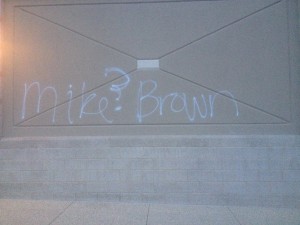Impact of Racial Injustice Goes Beyond Ferguson
October 3, 2014

Even though the unrest in Ferguson, Mo. over Michael Brown’s death is nearly a thousand miles away, the impact has been etched into our city. Bauer Drive, the Safeway plaza and parts of Baltimore Road were vandalized with “RIP Mike Brown” written on walls, in the streets and on road signs, along with the occasional “F*** the Feds” or “Call for new world order” graffiti.
In addition to this vandalism, students (including myself) have taken to social media to make sure that people understand what is going on in Ferguson and why it is important to know and talk about.
On the surface, the events unfolding in Ferguson seem easy to understand: 19-year-old Michael Brown was, allegedly, crossing the street Aug. 9 when a police officer, identified as Darren Wilson, approached him and shot him six times.
After Brown’s death, community members began to protest, rallying around Ferguson and demanding justice for the teen’s murder. There were several online livestreams of reporters at the scene when protesters were rallying. These livestreams depicted the Ferguson police releasing smoke grenades and tear gas into the crowd of protestors and shooting at them with rubber bullets, as well as destroying civilians’ private property.
Officer Wilson is on paid leave, and has been since Brown was murdered.
There are so many more factors in explaining the situation in Ferguson, but the most debated subject about the protests: events in Ferguson are not solely a response to standing up to police brutality.
When the attacks and protests first began, several news outlets focused on the brutality aspects alone. While police brutality is a severe issue in the United States, the events in Ferguson are to be blamed on the growing racism that was brewing in Ferguson prior to Brown’s murder. To insinuate otherwise is not accurately telling the story: it cuts out important pieces.
These pieces are not only crucial to the events centralized in Ferguson, but to all of the U.S. Racism is not gone in our society, and it is about time that the nation addressed it.
“Even though I live far from Ferguson a�� it has reminded me that an incident like the Mike Brown murder can happen anywhere in the U.S.,” junior Leo Blondel said. “Situations like this, I think, provide worry for people of color in any city or state. Being in danger of being shot at any given moment because of something like race is still a problem in our country.”
The Malcom X Grassroots Movement (www.mxgm.org) conducted a study in 2012 and found that every 28 hours, an unarmed black person is killed by police, security officers or vigilantes.
This number could even be higher. The organization recognizes this, publishing on the website that it is “sure that the actual number is closer to one state-sanctioned killing of a black person every 24 hours.”
The organization found names of 70 additional people killed by police nationwide whose race could not be confirmed and “countless others who the press never bothered to identify after police departments refused or delayed releasing their names.”
Racism with regard to police brutality is not just a Ferguson issue. These civilians killed by police were not all concentrated in Missouri, and the fact that we live in a country with statistics like this means that students who are not “white” are at a higher risk of police brutality.
The point of trying to clear up misconceptions and rumors about Ferguson is simple: raising awareness of the instinctive and often unconscious racism that is in American society.
“Knowing about Ferguson is important because learning from the incident is the only way to advance and prevent a similar tragedy in the future,” Blondel said. “There needs to be change.”
Seeking justice in Ferguson will not end with Wilson being charged with murder, police being required by law to have nametags and camera dashboards or laws restricting brutality. It will not grow to a nationwide level, and call attention to the racism in other parts of our society.
It will not escalate to nationwide level until people demand justice and refuse to let the issues that took place in Ferguson fade away. As citizens living in the greater D.C. area, we have an enormous power that we are not taking active advantage of: using our proximity to publically gather support and appeal to the government to address the atrocity of Ferguson.
As children of the digital age, we also have the power to continuously inform and educate friends, relatives and followers on the Internet about the events that are going on. Remaining active in the fight to address racism and police brutality is the only way that it will ever be dealt with.
Maybe one day, we can live in a world where people of a wide range of skin tones can walk down the street and not fear for their lives.


